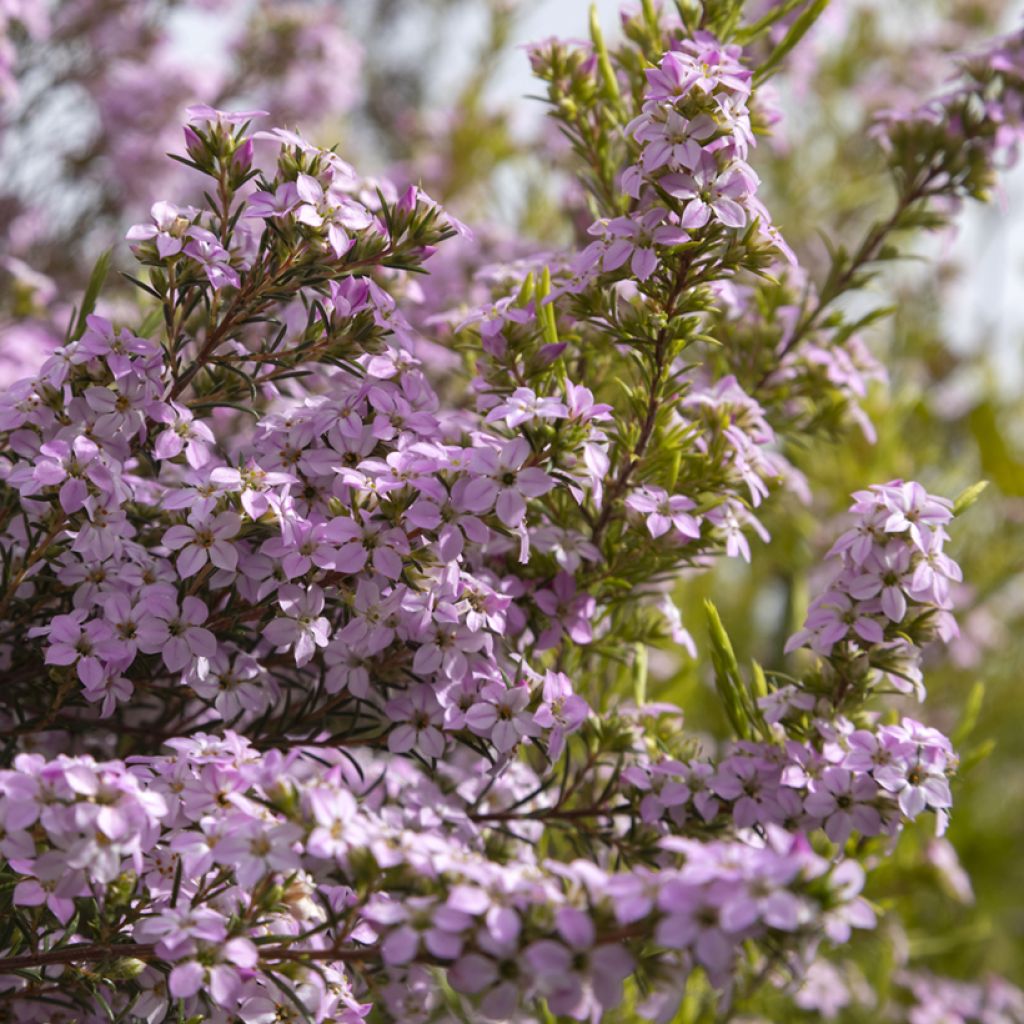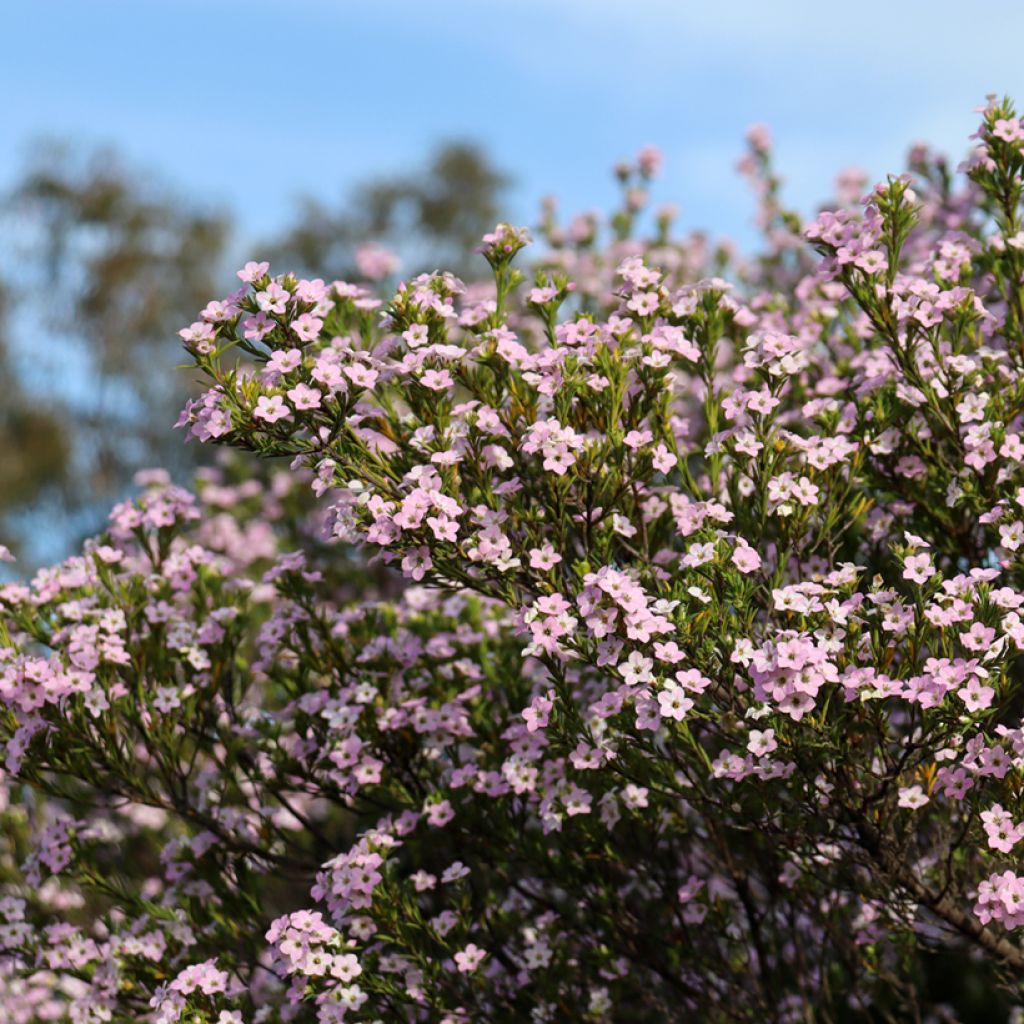

Diosma hirsuta Pink Diamond


Diosma hirsuta Pink Diamond


Diosma hirsuta Pink Diamond


Diosma hirsuta Pink Diamond


Diosma hirsuta Pink Diamond


Diosma Pink Diamond
Diosma hirsuta Pink Diamond
Diosma hirsuta Pink Diamond
Out of the 4 received, two have died. What a shame. The other two are still in bloom in this month of January. They are in a conservatory. The foliage isn't very fragrant, but they are lovely plants.
Jean-Claude, 23/01/2024
Special offer!
Receive a €20 voucher for any order over €90 (excluding delivery costs, credit notes, and plastic-free options)!
1- Add your favorite plants to your cart.
2- Once you have reached €90, confirm your order (you can even choose the delivery date!).
3- As soon as your order is shipped, you will receive an email containing your voucher code, valid for 3 months (90 days).
Your voucher is unique and can only be used once, for any order with a minimum value of €20, excluding delivery costs.
Can be combined with other current offers, non-divisible and non-refundable.
Home or relay delivery (depending on size and destination)
Schedule delivery date,
and select date in basket
This plant carries a 24 months recovery warranty
More information
We guarantee the quality of our plants for a full growing cycle, and will replace at our expense any plant that fails to recover under normal climatic and planting conditions.
Would this plant suit my garden?
Set up your Plantfit profile →
Description
Diosma hirsuta Pink Diamond is a variety of hairy diosma that stands out for its flowers of a brighter pink than those of the famous 'Pink Fountain'. It is an undershrub that is frost-tolerant, and particularly floriferous, adapted to seaside gardens and also for terraces and balconies. The plant, which resembles heather, forms a beautiful foliage ball covered with small pink flowers from late winter to early summer. Its small tender green leaves emit a pleasant fragrance when touched. When planted in a container or pot, it can be placed outdoors during the warm season and protected from the cold during winter.
Diosma hirsuta Pink Diamond is a woody-based shrub plant from the rutaceae family, just like lemon trees. It is native to the Cape region of South Africa, particularly the valleys and slopes of the Cederberg, where it grows in non-chalky soils. It should not be confused with Coleonema, a very similar genus that provides shrubs reaching over 1.50 m (4 ft 11 in) in height and tolerant of limestone. The hairy diosma has produced some beautiful cultivars with flowering ranging from white to red.
'Pink Diamond' is a particularly colourful cultivar and forms a very bushy miniature shrub with a dense and slightly spreading habit. It reaches about 40-50 cm (15.7-19.7 in) in height and 50-60 cm (19.7-23.6 in) in width at the age of 10 years. Its flexible brown stems bear acidic green foliage on young shoots, darkening over time. The very fine leaves, measuring 7 to 10 mm (0.3 to 0.4 in) in length, are very hairy, glandular and aromatic. They emit a spicy fragrance when touched. They have no petioles and are arranged alternately and erect. The very long flowering, occurs from February to June-July, depending on the climate, and lasts about 4 months. The numerous star-shaped, fragrant and nectar-rich flowers do not exceed 7 mm (0.3 in) in diameter. Each flower is composed of 5 petals and 5 stamens. Their light pink colour turns into a brighter pink over time, even red towards the end. They are either solitary or grouped in terminal clusters and are followed by the formation of green, aromatic fruits containing 5 small black seeds.
Diosma Pink Diamond is a very pretty ericaceous or sandy soil plant, very useful for enhancing the landscape of a coastal garden or a large rockery, provided that winter temperatures do not drop below -5°C for short periods. It can be associated with heathers or plants from garrigues or scrub vegetation such as cistus, rosemary, lavender, thyme, or even Teucrium in mild climates. In most regions, it will make a beautiful orangery or lightly heated veranda plant where it will form, along with an orange tree, a Boronia heterophylla or a mimosa, a fragrant and extremely decorative scene.
Report an error about the product description
Diosma hirsuta Pink Diamond in pictures




Plant habit
Flowering
Foliage
Botanical data
Diosma
hirsuta
Pink Diamond
Rutaceae
Cultivar or hybrid
Planting and care
Diosma hirsuta Pink Diamond only thrives in open ground in mild coastal climates. It will thrive in light, well-drained soil, even sandy or rocky, acidic to neutral (it does not like limestone). A light soil, whether humic, slightly rocky or sandy, will do the trick. It tolerates sea spray well. Plant it after the last frost. It will flourish in the sun and likes to have warm roots. Under these conditions, it is hardy down to -5°C/-6°C (21.2 °F) and can live for many years. Cover with fleece in cold regions during winter, protect it from the cold as much as possible. Place it in the warmest corner of the garden, in full sun against a south-facing wall. Once well established, it will require no watering in summer. In colder regions it will be necessary to grow it in a large pot to store it during winter, in a bright but unheated room. To shape it, you can lightly prune the stems after flowering to encourage the plant to branch out.
Cultivation in pots:
Ensure good drainage in the bottom of the pot. Use a light substrate, enriched with leaf compost and coarse sand, and add a little slow-release fertilizer at the end of winter. Do not bury the collar of the plant. Water regularly in summer, allowing the soil to dry out a little between waterings.
Planting period
Intended location
Care
-
, onOrder confirmed
Reply from on Promesse de fleurs
Similar products
Haven't found what you were looking for?
Hardiness is the lowest winter temperature a plant can endure without suffering serious damage or even dying. However, hardiness is affected by location (a sheltered area, such as a patio), protection (winter cover) and soil type (hardiness is improved by well-drained soil).

Photo Sharing Terms & Conditions
In order to encourage gardeners to interact and share their experiences, Promesse de fleurs offers various media enabling content to be uploaded onto its Site - in particular via the ‘Photo sharing’ module.
The User agrees to refrain from:
- Posting any content that is illegal, prejudicial, insulting, racist, inciteful to hatred, revisionist, contrary to public decency, that infringes on privacy or on the privacy rights of third parties, in particular the publicity rights of persons and goods, intellectual property rights, or the right to privacy.
- Submitting content on behalf of a third party;
- Impersonate the identity of a third party and/or publish any personal information about a third party;
In general, the User undertakes to refrain from any unethical behaviour.
All Content (in particular text, comments, files, images, photos, videos, creative works, etc.), which may be subject to property or intellectual property rights, image or other private rights, shall remain the property of the User, subject to the limited rights granted by the terms of the licence granted by Promesse de fleurs as stated below. Users are at liberty to publish or not to publish such Content on the Site, notably via the ‘Photo Sharing’ facility, and accept that this Content shall be made public and freely accessible, notably on the Internet.
Users further acknowledge, undertake to have ,and guarantee that they hold all necessary rights and permissions to publish such material on the Site, in particular with regard to the legislation in force pertaining to any privacy, property, intellectual property, image, or contractual rights, or rights of any other nature. By publishing such Content on the Site, Users acknowledge accepting full liability as publishers of the Content within the meaning of the law, and grant Promesse de fleurs, free of charge, an inclusive, worldwide licence for the said Content for the entire duration of its publication, including all reproduction, representation, up/downloading, displaying, performing, transmission, and storage rights.
Users also grant permission for their name to be linked to the Content and accept that this link may not always be made available.
By engaging in posting material, Users consent to their Content becoming automatically accessible on the Internet, in particular on other sites and/or blogs and/or web pages of the Promesse de fleurs site, including in particular social pages and the Promesse de fleurs catalogue.
Users may secure the removal of entrusted content free of charge by issuing a simple request via our contact form.
The flowering period indicated on our website applies to countries and regions located in USDA zone 8 (France, the United Kingdom, Ireland, the Netherlands, etc.)
It will vary according to where you live:
- In zones 9 to 10 (Italy, Spain, Greece, etc.), flowering will occur about 2 to 4 weeks earlier.
- In zones 6 to 7 (Germany, Poland, Slovenia, and lower mountainous regions), flowering will be delayed by 2 to 3 weeks.
- In zone 5 (Central Europe, Scandinavia), blooming will be delayed by 3 to 5 weeks.
In temperate climates, pruning of spring-flowering shrubs (forsythia, spireas, etc.) should be done just after flowering.
Pruning of summer-flowering shrubs (Indian Lilac, Perovskia, etc.) can be done in winter or spring.
In cold regions as well as with frost-sensitive plants, avoid pruning too early when severe frosts may still occur.
The planting period indicated on our website applies to countries and regions located in USDA zone 8 (France, United Kingdom, Ireland, Netherlands).
It will vary according to where you live:
- In Mediterranean zones (Marseille, Madrid, Milan, etc.), autumn and winter are the best planting periods.
- In continental zones (Strasbourg, Munich, Vienna, etc.), delay planting by 2 to 3 weeks in spring and bring it forward by 2 to 4 weeks in autumn.
- In mountainous regions (the Alps, Pyrenees, Carpathians, etc.), it is best to plant in late spring (May-June) or late summer (August-September).
The harvesting period indicated on our website applies to countries and regions in USDA zone 8 (France, England, Ireland, the Netherlands).
In colder areas (Scandinavia, Poland, Austria...) fruit and vegetable harvests are likely to be delayed by 3-4 weeks.
In warmer areas (Italy, Spain, Greece, etc.), harvesting will probably take place earlier, depending on weather conditions.
The sowing periods indicated on our website apply to countries and regions within USDA Zone 8 (France, UK, Ireland, Netherlands).
In colder areas (Scandinavia, Poland, Austria...), delay any outdoor sowing by 3-4 weeks, or sow under glass.
In warmer climes (Italy, Spain, Greece, etc.), bring outdoor sowing forward by a few weeks.








































